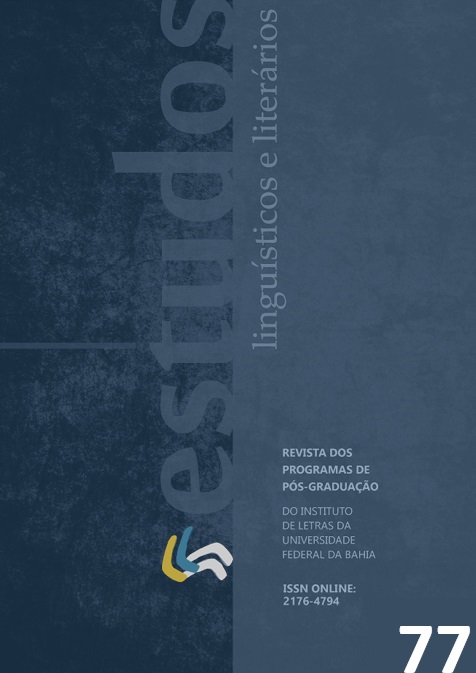MORE ON NEGATION IN BRAZILIAN PORTUGUESE
DOI:
https://doi.org/10.9771/ell.v0i77.61685Palavras-chave:
Negation; Progressive and perfective periphrases; Syntax; Brazilian Portuguese.Resumo
There is an innovative use for the negation in Brazilian Portuguese (henceforth, BP): the negative marker não ‘no’ (henceforth, ‘low não’) is possible in a position between the auxiliary and the uninflected verb in perfect and progressive periphrases. Since negation cannot appear in that position in other Romance languages, I discuss a possible analysis for this new construction. First, I discuss the properties of the possible ‘inhibited eventualities’ in Spanish (Fábregas; González-Rodríguez 2019, 2020, 2021) to check their similarities and differences with BP ‘low não’. Second, I consider which position could qualify as a syntactic position for ‘low não’ given its properties and the literature on multiple positions for negation (Declercq, 2013). Then, assuming Ramchand (2018)’s proposal, I propose that, differently from English, the auxiliary verbs of both these periphrases are generated inside vP in BP. Additionally, I assume that ‘low não’ became possible in BP due to the loss of lexical verb movement to a high functional category in the language. Thus, the lexical verb moves only as high as a lower (aspectual) projection, whereas the auxiliary separately moves up to a higher position (Cyrino, 2013; Cyrino; Araújo-Adriano, 2023).
Downloads
Referências
ARAÚJO-ADRIANO, P. Â. The present tense analyticisation process in Brazilian Portuguese: a diachronic approach. 2023. Tese (Doutorado em Linguística) – Universidade Estadual de Campinas, Campinas.
ARKADIEV, P. 2015. Negative events: Evidence from Lithuanian. In: ARKADIEV, P.; KAPITONOV, I.; LANDER, Y.; RAKHILINA, E.; TATEVOSOV, S. (eds.). Donum semanticum: Opera linguistica et logica in honorem Barbarae Partee a discipulis amicisque Rossicis oblate. Moscow: LRC Publishing, 2015. p.7–20.
BELLETTI, A. Aspects of the low IP area. In: Rizzi, L. (ed.) The structure of IP and CP: the cartography of syntactic structures. Oxford: Oxford University Press, 2004, p. 16–51.
CAVALCANTE, R. Negação anafórica no português brasileiro: negação sentencial, negação enfática e negação de constituinte. 2012. Tese (Doutorado em Linguística) – Universidade de São Paulo, São Paulo.
_____. A negação pós-verbal no português brasileiro: análise descritiva e teórica de dialetos rurais de afro-descendentes. 2007. Dissertação (Mestrado em Letras e Linguística) – Universidade Federal da Bahia, Salvador.
CYRINO, S. More on negation in Brazilian Portuguese. Paper presented at the IV Encontro de Gramática Gerativa, Universidade Federal da Bahia, March 28-30. 2023.
_____. More on negation in Brazilian Portuguese. Paper presented at the History of Negation Seminar, University of Yale- University of Bologna. October 27, 2022. 2022a.
_____. More on negation in Brazilian Portuguese. Paper presented at the Romance Linguistics at Cambridge (RoLinC) Seminar. University of Cambridge & University of Newcastle, November 1, 2022. 2022b.
_____. On richness of tense and verb movement in Brazilian Portuguese. In: CAMACHO-TABOADA, V.; JIMÉNEZ-FERNÁNDEZ, Á.; MARTÍN-GONZÁLEZ, J.; REYES-TEJEDOR, M. (eds.). Information Structure and Agreement. Amsterdam: John Benjamins Publishing, 2013. p. 297–317.
_____. On complex predicates in Brazilian Portuguese. Ibéria- International Journal of Theoretical Linguistics. v. 2, n. 2, 2010. http://www.siff.us.es/iberia/index.php/ij/index
_____. A sintaxe da negação o português brasileiro: novas perperspectivas de análise e subsídios para o estudo da história da negação. Projeto Produtividade em Pesquisa, CNPq 303015/2022-5, in progress.
CYRINO; ARAÚJO-ADRIANO, P. Â. On the loss of verb movement in BP and the emergence of structural gaps in auxiliary + verb constructions. Trabalho apresentado no IV Generative Grammar Meeting. Universidade Federal da Bahia, 2023.
CYRINO; BIBERAUER, T. Appearances are Deceptive: Jespersen’s Cycle from the Perspective of the Romania Nova and Romance-based Creoles. Paper presented at Going Romance 23. University of Nice, Nice. 2009.
CYRINO; MATOS G. Local licensers and recovering in VP ellipsis. Journal of Portuguese Linguistics n. 4. p. 79–112, 2005.
DECLERCQ, K. A unified syntax of negation. PhD Dissertation, University of Gent, 2013.
DE PAULA, D.C.F. O sintagma verbal em português: construções perifrásticas e não-perifrásticas. 2014. Dissertação (Mestrado em Linguística) – Universidade Estadual Paulista, São José do Rio Preto.
FÁBREGAS, A.; GONZÁLEZ-RODRÍGUEZ, R. Negation with Participles and Inhibited Events. Linguistic Analysis, v. 43, p. 1–2, 2021.
_____. On inhibited eventualities. Natural Language and Linguistic Theory, v. 38, p. 729–773, 2020.
_____. Perífrasis e inductores negativos: un análisis en términos de domínios. Onomázedin, v. 43, p. 95–11, 2019.
GIORGI, A.; PIANESI, F. Tense and Aspect. Oxford: Oxford University Press, 1997.
JARRAH, M.; ABUSALIM, N. In favor of the low IP area in the Arabic clause structure. Natural Language and Linguistic Theory, v. 39, p.123–156, 2021.
MENDES, R. Estar + gerúndio e ter + particípio: aspecto verbal e variação no português. 2005. Tese (Doutorado em Linguística) – Universidade Estadual de Campinas, Campinas.
OUWAYDA, S.; SHLONSKY, U. The wandering subjects of the Levant: “Verbal Complexes” in Lebanese Arabic as phrasal movement. Brill’s annual of Afroasiatic languages and linguistics v. 8, p. 136–153, 2016.
POLETTO, C. On negative doubling. Quaderni di lavoro ASIT v. 8 p. 57–84, 2008.
RAMCHAND, G. Situations and syntactic structures. Cambridge: The MIT Press, 2018.
_____. First phase syntax. Cambridge: Cambridge University Press, 2008.
RAMCHAND, G.; SVENONIUS, P. Deriving the functional hierarchy. Language Sciences v. 46, p. 152–174, 2014.
SCHWENTER, S. 2005. The pragmatics of negation in Brazilian Portuguese. Lingua, v. 115, n. 10, p. 1427–1456, 2005.
TEIXEIRA DE SOUSA, L. Three types of negation in Brazilian Portuguese. Lingua, v. 159, p. 27–46, 2015.
TRAVIS, L. Parameters and effects of word order variation. 1984. Doctoral dissertation – Massachusetts Institute of Technology, Massachusetts.
VENDLER, Zeno. Linguistics in philosophy. Ithaca: Cornell University Press, 1967.
ZANUTTINI, R. Negation and clausal structure: a comparative study of Romance languages. Oxford: Oxford University Press, 1997.
_____. On the relevance of tense for sentential negation. In BELLETTI, A.; RIZZI, L. (eds.). Parameters and Functional Heads: Essays in Comparative Syntax. Oxford: Oxford University Press, 1996. p. 181–207.


